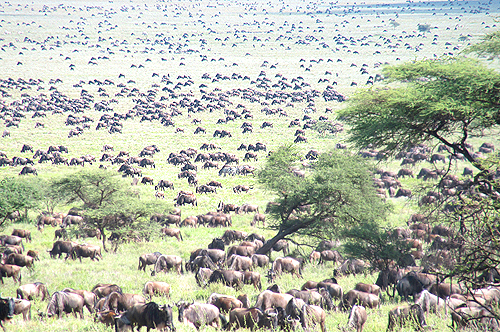
But that has to remain an estimate. We made no aerial survey, no individual counting. It’s my opinion, but one rendered from forty years of doing this. And whether my numbers are off or not, I can absolutely say that it was among the very best migration experiences of my career.
Brewster Johnson asked me today at Naabi Hill how often we could see the scene around us, and I replied if the weather is normal, every March and April.
That’s pretty true for the south side of the hill we were on at the time: the wilde surrounded the south side from as far as we could see towards Lemuta to the Kusini Plains where the swath ended.
But as we pulled over the hill we could see almost as many again northeast towards Gol and somewhat towards Moru. And combined with what we had seen for the last few days in more distant places like Lemuta, this experience this year was extremely unique.
Today we moved from the southwest tip of the Serengeti at Ndutu into the center, via Naabi Hill. Yesterday evening as we watched yet another line stream into the Ndutu forests (which we could not see from our vantage point today at Naabi) we watched the end of the line brought up by a lost calve.
Hardly had I mentioned that the calve wouldn’t last then we saw a hyaena run after it, easily catching its tail, then immediately start eating it alive.
The scene was disturbing to some on my current trip and is understandably disturbing to many, and to dismiss these feelings by just saying “This is the wild,” is inadequate.
What the “wild is” is not an easy concept. Hyaena are as essential to the wild as baby wildebeest. Hyaena killing baby wildebeest are as essential to the wild as babies being born to wildebeest.
Today we also saw wild dog. Wild dog and hyaena are the most gruesome killers, and wild dog look remarkably cuddly and loving, no less than a slurping lab. But both animals eat their prey before they kill it.
Why that particularly gruesome way of recycling has evolved may be more a reflection of our own consciousness than any comment on what the wild is.
But above all, it’s the perfect lesson on why we need diligently to keep ourselves from anthropomorphizing wild animals.
